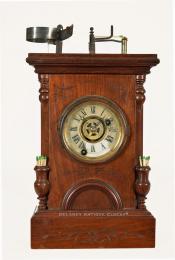Henry J. Davies. An Illuminating Alarm Clock. Mantel of shelf clock. YY-54.
This Illuminated Alarm Clock was made circa 1876 by Henry Davies of New York. On August 25, 1867, Henry J. & Walter D. Davies applied for a patent to improve alarm clocks' lighting attachments. This is one version of one such improvement. We have seen at least four other examples of this type of illuminating alarm clock. This version is more sophisticated in terms of case form and proportions.
This fine example features a case constructed in walnut and retains an older surface. Many of the front surfaces are inscribed with scroll decoration. This is nicely done and adds to the interest in the overall case design. The front corners of the main body of the case are canted. Decorative turnings are positioned at the top and bottom of this corner detail. The lower decorations are in the form of stylized urns mounted up on pedestals. The urns are hollowed out, allowing one to store additional matches. They are, in effect, match holders. The upper two decorations are in the form of drop finials and taper to a point. The pendulum can be accessed through a removable half-round-shaped door in the front of the case. This is trimmed with applied molding. The dial bezel is brass and is fitted with glass. It swings open to access the 3.5-inch diameter paper dial that is applied to a tin pan. The dial is formatted with Roman-style hour numerals and a brass alarm disk that is located in the center. The top of the case is very unusual because it has been constructed to house an oil lamp and the mechanism of lighting. This is on display for all to see. The oil lamp is removable and fitted into a slot on the right side of the case. A partial label from the clockmaker is pasted onto the back of the case. The clock mechanism in this example is H. J. Davies's design. I have also seen examples with movements made by the Ansonia Brass & Copper Co. This example is a time and alarm design. It is constructed in brass and powered by coil springs. It will run for thirty hours. The alarm bell is located inside the case mounted to the backboard.
This very unusual clock measures 15 inches tall to the top of the lighting device and 8.25 inches wide.
To set this alarm, one needs to perform the following procedure. First, it may be best to ensure the lamp is fueled and the wick is exposed and in good order. Next, install a wooden match in the spring-loaded holder. This is located in the center of the case and is in the form of a pillar. Cock or load the match to the left, positioning it against the spring located on the left side of the case. Sandpaper has been glued to a section of the spring. The spring is drawn out until the latch holds it in place. At this point, the match should be positioned against the sandpaper and locked into a ready position. One then would set the alarm from the brass disk located in the center of the dial. You would also need to wind this part of the mechanism with a key through the dial at the position of 6:45. When the alarm is tripped, a latch releases the spring. The result is that the head of the match will draw against the sandpaper on the spring as it turns to the right. The head of the match will fire as it comes into position over the oil lamp. This will illuminate the room.
This is a neat clock.
Inventory number YY-54.
Henry J. Davies operated a clock-related business at No. 5 Courtland Street in New York, New York, from 1858 through 1886. Today, Davies is probably best known for his Crystal Place mantel clock design. This clock, introduced in 1874, was displayed under a glass dome. Oftentimes, figures were mounted aside from the mounted movement and usually incorporated a mirror behind the pendulum. The vast majority of these clocks were powered by Ansonia manufactured movements and were later cataloged as Ansonia clocks when Davies became the General Manager of the Brooklyn, New York plant. Davies also received several patents for his designs, including one for the now very collectible illumination alarm clock. These alarm clocks were designed to mechanically strike a match which in turn lit an oil lamp mounted in the clock’s case. The result was the illuminating of the room. One then could easily make their way around the interior or perhaps read the clock's dial. This system was to compete with the simple and safe bell alarm format.








